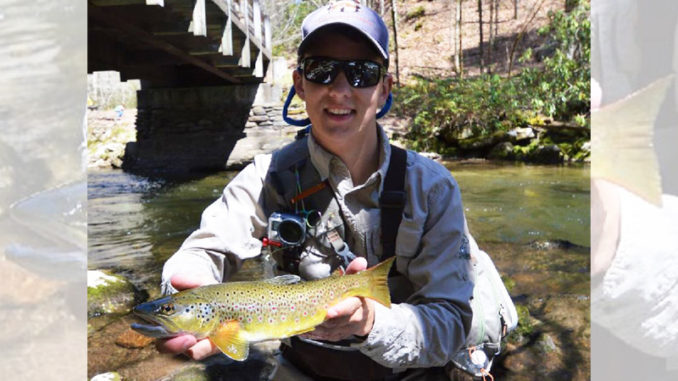
This European import has changed the way trout fishermen ply their craft across North America
When it comes to trout fishing, brown trout are the kings. They grow bigger, live longer, fight harder and are more difficult to catch than brook and rainbow trout.
Beautifully colored and easy to identify, they have golden brown sides, bright yellow bellies and dark and red spots liberally sprinkled on their backs and sides. The English priest-poet Gerard Manley Hopkins called the spots “rose moles” in one of his poems.
Although widely distributed in the West and East, browns are not native to North America. They’re native to Europe and eastern Asia and were brought to the United States in 1883. Fred Mather, a New York fisheries biologist, acquired brown trout eggs from Germany and Scotland and placed them in hatcheries in New York and Michigan. Some fishers still refer to brown trout as “German browns.” The fish eventually were distributed throughout North America.
Browns adapted well to their new habitat and thrived in conditions less suitable for rainbow and brook trout, particularly silted and low-gradient streams.
Unlike brook and rainbow trout, which have short life spans of 3 to 4 years, brown trout can live up to 20 years. The downside is that fewer than 20 percent of browns survive after spawning in the fall.
Record keeping
The state record for a brown trout caught in North Carolina waters is 24 pounds, 10 ounces, from the Nantahala River. The section of the river that produced the record brown is stocked, delayed-harvest waters, so the record brown was likely a hatchery-raised fish that had survived several seasons. The state record for a brown trout in South Carolina is 17 pounds, 10 ounces, caught in Lake Jocassee; this one, no doubt, was a wild brown. The world record is 40 pounds, 4 ounces, caught in the Little Red River in Arkansas in 1990.

With a few exceptions, wild trout streams throughout western North Carolina and Upstate South Carolina contain a mix of rainbow and brown trout. The bigger browns thrive in large valley streams, subsisting primarily on crawfish, salamanders, sculpins, and similar aquatics.
The brownest waters
Prime brown trout streams in North Carolina are the Nantahala River, Toe River, Big Snowbird Creek, Davidson River, Hazel Creek (lower section), Tanasee and Forney Creek (lower section). The Catawba River in Burke County from Muddy Creek to the Morganton city intake dam is classified as special-regulation waters and regularly produces trophy browns. Creel limit is two trout per day 14 inches or longer. Fishing is permitted year-round, and the stream has no bait restrictions.
The best brown trout fishery in South Carolina, by far, is Lake Jocassee in Pickens and Oconee counties. Jocassee’s browns average 3 to 5 pounds; other prime brown trout steams are the lower Saluda River below Dreher Falls and the lower Chattooga River.
Best places to catch browns are undercut banks, around downed trees and around rock ledges. Brown trout also favor large, murky pools. Best time to fish for browns is late afternoon and early evening when the sun is off the water. Browns also are active after a storm and are less spooky than normal.
To catch big browns, use big flies, spinners and lures. Big streamers such as Woolly Buggers and sculpin patterns are effective, as are lures simulating crawfish and minnows. During the summer, large terrestrial patterns work well, particularly grasshopper and junebug patterns.
Fishing for browns requires much patience and leg work, but the reward of hooking a big brown is worth every bit of the effort.

